Furo Kōgō

When welcoming guests into the Tearoom, incense is burned before the guests enter – kō wo taku, 香を焚く, incense to burn. The first of the three offerings in Buddhism is kō, 香, incense: the others are ge, 華, flower, and tō, 灯, light. Before the guests enter the Tearoom, the tei-shu, 亭主, house-master, puts incense in the hearth, shiki-kō, 敷香, spread-incense, before placing the shita-bi, 下火, down-fire, three pieces of burning charcoal.
When the guests are present in the Tearoom, the tei-shu, 亭主, house-master, may build the charcoal fire to heat the water for tea in a presentation called sumi de-mae, 炭手前, charcoal hand-fore, and incense is added to the fire. Incense to be put into the fire is held in a kō-gō, 香合, incense-gather.
When using the fu-ro, 風炉, wind-hearth, to boil water for tea, byaku-dan, 白檀, white-sandalwood, is put in the charcoal fire. When using the sunken hearth, ro, 炉, a blend of aromatics called neri-kō, 練香, knead-incense, is put into the hearth.
Buddhist images were and are carved from timber of precious and aromatic woods, and as the image is sacred, so are the chips and sawdust that are created. These bits and pieces must be assembled and used in worship. Hence ji-shu-kō, 十種香, ten-kinds-incense, which are put into containers on altars, and offered to deities.
Burning incense in Buddhist temples was essential to worship, and in the E-do Ji-dai, 江戸時代, Port-door Time-period, the Tokugawa government ordered everyone to be Buddhist. Therefore, it was necessary to have incense and incense containers and burners for the home altar. Various types of incense were burned. Crumbles of aromatic woods for prayers were put on pieces of burning charcoal. Sen-kō, 線香, thread-incense, burned by itself for meditation, as were other molded forms that burn on their own. Senkō may not have an organized procedure.

In the appreciation of incense, called Kō–dō, 香道, Incense-way, small pieces of kō-boku, 香木, incense-wood, are burned in kō-ro, 香炉, incense-heart, and are held in kasane kō-gō, 重香合, stack incense-gather.
Kasane kō-gō H. 2.4 x 1.8 sun kane-jaku. This establishes the diameter of the kōgō. The kasane kōgō has three tiers and a lid. The top tier is for the incense in paper folders, the second is for ginyō, the bottom is lined with metal for burnt out incense and used ginyō. The top tier and lid could be removed, and could become a standard kōgō with a height of one sun kane-jaku.
Sen no Rikyū had specific objects used when burning incense with the furo and ro, and these are written in Rikyū Hyaku-shu, 利休百首, Rikyū Hundred-poems.
Ro no uchi wa sumi-tori hisago e-no-hi-bashi tō-ki neri-kō toshire.
炉のうちは炭斗瓢柄の火箸 陶器香合ねり香としれ.
Hearth’s within as/for charcoal-measure gourd handle’s fire-rods knead-incense use.
It is interesting that Rikyū mentions kōgō for ro first rather than that for furo.
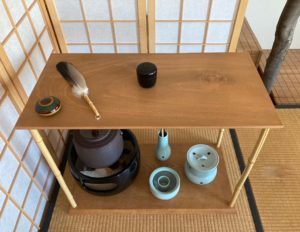

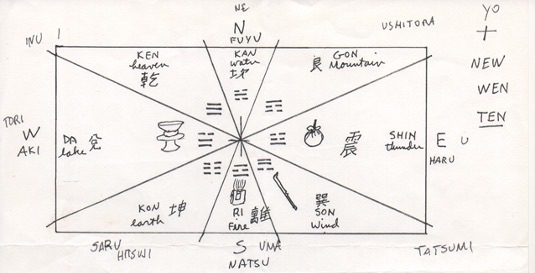
Left: temporary location of the kōgō on the tatami when taken from the ten-ita, 天板, heaven-board, of the dai-su, 台子, support-of, at the beginning of sumi de-mae, 炭手前, charcoal hand-fore. Right: diagram of daisu tenita with utensils and trigrams of the Eki-kyō, 易経, Change-sutra. The location of the kōgō is on the trigram Kon, 坤, Earth.

The kōgō is placed to the left and in front of the daisu on the floor [black dot at Heaven]. The floor of the yojōhan is identified with the trigrams of the Ekikyō, and this location is identified with the trigram Ken, 乾, Heaven. The tokonoma is also identified with the trigrams of the Ekikyō, which extends into the room, and the location of the kōgō with regard to the tokonoma is identified also with the trigram Ken, Heaven. It should be remembered that the kōgō originally was located on the ten-ita, 天板, heaven-board of the daisu. Although the kōgō was moved, it remains identified with heaven.
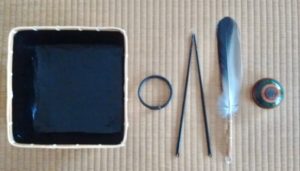
The utensils for building the charcoal fire may represent the Go-rin, 五輪, Five-rings – from left: square sumi-tori, 炭斗, charcoal-measure, symbolic of Earth; pair of round kan, 鐶, metal rings, symbolic of and handles Water; triangle pair of hi-bashi, 火箸, fire-rods, symbolic of and handles Fire; ha-bōki, 羽箒, feather-brush, symbolic of Wind, kō-gō, 香合, incense-gather, symbolic of the Void. The number of pieces of charcoal in the sumi-tori to be places in the furo are five, and which may be symbolic of the Gorin.

The kōgō is placed on a piece of charcoal called kō-gō dai, 香合台, incense-gather support, which is not put into the fire. This piece of charcoal, gi-tchō, 毬打, ball-hit, may be identified with the sun. Another piece of charcoal in the sumitori that is not put into the fire is a wari-gi-tchō, 割毬打, divided-ball-hit, that is also called the makura-zumi, 枕炭, pillow-charcoal, which may be identified with the half-moon.
From Rikyū’s poems:
Fu-ro no toki sumi wa sai-ro ni kane hi-bashi nuri kō-gō ni byaku-dan wo take.
風炉の時炭は菜籠にかね火箸 ぬり香合に白檀をたけ. Rikyū.
Wind-hearth’s time charcoal vegetable-basket in metal fire-rods lacquered incense-gather in white-sandalwood to burn.
The Kanji dan, 檀, sandalwood, is composed of moku, 木, tree, and tan, 亶, truly, which is also part of the Kanji for dan, 壇, altar, which implies that it has been highly revered from an early age.
The furo was the original means of heating water for tea, and byaku-dan, 白檀, white-sandalwood, was the preferred incense having a long-time presence in Buddhist and other offerings. When the ro was used for heating water for tea, neri-kō was chosen. Because neri-kō may be damp, it was thought that it might damage the lacquered surface of the kōgō used with the furo, and so Rikyū preferred a kōgō made of ceramic. There are, of course, exceptions.
Byakudan/sandalwood is so closely associated with Buddhism. The body of the Buddha had the scent of sandalwood. After the Buddha’s death, the fuel for his cremation fire was sandalwood.
Byaku-dan is white sandalwood, and there are other types. The tree is Santalum album. Its roots parasitize plants that grow nearby. In the areas where sandalwood trees grow, snakes climb into the trees to cool their bodies in summer’s heat. Snakes and other serpents are both friend and foe of Buddhism. The great snake, Mucalinda, protected the Buddha from storms during his meditation that led to his enlightenment.
The furo is the original source of hot water and the necessary fire to heat it. When the furo is placed on the jiita of the daisu, the kōgo and habōki, both of which are used with the furo, are displayed on the tenita above the furo. The usu-ki, 薄器, thin-container, is placed in the center of the tenita as tea is the center of the world.
The kōgō may be of any size, shape, origin, historical material, and made of stone, shell, tortoise shell, plastic, etc., lacquered turned wood covered container. Many kōgō were adapted from small cases that held shu-niku ire, 朱肉入, vermilion-flesh receptacle. These are usually small covered containers with vermilion paste used to stamp documents. Personal ink containers were small, while official holders can be large, as the stamps themselves are large. Historically, ink-paste containers originating in China were made of metal, ceramic, lacquered wood, etc.
Fine incense can be costly. A box of fine quality ji-shu-kō, 十重香, ten-kinds-incense, from a retail store in Japan for 250g may cost from $35. to $500, so that it is apparent fine each minute grain of fine wood is precious. Shō-yei-dō, 松栄堂, Pine-splendor-hall, Kyōto. In spite of its name, the crumbles of incense wood may be of a single type, or a blend of various woods and other ingredients. The number ten symbolically implies in ‘all eight directions’ and up and down, omnipresence.
The kōgō may be placed on the ten-ita of the daisu, as well as the top shelf of a display stand tana, 棚, shelf. According to the arrangement of the trigrams of the Ekikyō, identified with the ‘new’ arrangement of the ha-kke, 八卦, eight-signs, the kōgō is placed on the trigram Kon, 坤, Earth. Composed of tsuchi, 土, earth, and the original form of the Kanji for lightning saru, 申. This is the Kanji for the zodiac sign for Saru, Monkey, southwest, etc. This location is also the realm of Dai-nichi, 大日, Great-sun.
When using the furo, the kōgō is taken from the tenita and placed on the tatami to the left of the jiita. This is the same location as the futaoki when using the furo. According to the Ekikyō, this location is identified with the trigram Shin, 震, Thunder. It should be remembered that the futaoki is identified with the same trigram for Thunder, and that the ideal futaoki is the ho-ya gō-ro futa-oki, 火舎香炉蓋置, fire-house incense-hearth lid-place.
The kōgō is ideally made of wood(and lacquered according to Rikyū), and the ideal incense is byakudan/sandalwood, which is also wood. According to the Ekikyō, wood is identified with the trigram Son, 巽, Wind. Were the trigrams for Wind and Earth to be combined, the hexagram is 20 Kan, 観, Appearance, see, outlook, condition, view, etc. The Kanji kan, 観, is the start of the name of the Buddhist Goddess of Mercy, Kan-non, 観音, See-sound. Again, in Japan, one listens to incense, which may allude to Kannon, who hears and sees everything.
The words ‘wind’ and ‘wood’ have the same letters at the beginning and end – ‘w’ and ‘d’. The inner letters make the words ‘in’ and ‘oo’, which have through mere coincidence a vague similarity with In and Yō.
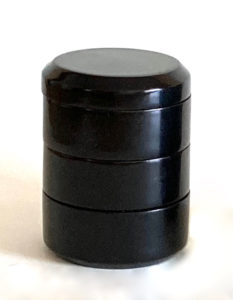


After Rikyū’s death, his confiscated property was returned by Hideyoshi to the Sen family. Included was a gift a ko-ma kō-gō, 独楽香合, solitary-pleasure incense-gather. The koma was Hideyoshi’s crest, which he had bestowed on Rikyū. The ko-ma mon, 独楽紋, solitary-pleasure crest, is the crest worn by the Ie-moto, 家元, House-head, of the Sen families.
The koma is a representation of the hō-ju, 宝珠, treasure-jewel, that is in motion. Japanese tops are spun in both directions, however, an aged Japanese master top-maker spins his little tops with his thumb and fore-finger so that they turn clockwise. Large tops with a long metal rod axis he turns with both hands counter-clockwise.
The red-lacquered ko-ma kō-gō, 独楽香合, solitary-pleasure incense-gather, is likened to a child’s top, ko-ma, 独楽, solitary-pleasure, with its concentric rings. There is significance to the number of rings: seven on the top, five on the side. There are three pieces of byakudan inside. The kōgō is one object. In Japanese belief, uneven numbers are auspicious as they cannot be equally divided, so that they regarded as positive, Yō, 陽, Yang.


Why three pieces of byakudan? Two pieces are placed into the furo fire, one is left in the kōgō for the guest to see. Byakudan chips for Chanoyu measure 5 bu kane-jaku square. The total length of the pieces of charcoal put into the furo is 20 sun kane-jaku.
Missing in the equation is the incense that is added to both hearths. Incense that is put in the furo is byaku-dan, 白檀, white-sandalwood. Two square pieces of hewn wood each are 5 bu kane-jaku square totaling one additional sun kane-jaku added to 20 sun kan-jaku of charcoal totaling 21 sun kane-jaku. Incense added to the ro is neri–kō, 練香, kneaded-incense, which is a blend of aromatics combined with charcoal dust, honey and water to form a very dense and heavy paste. The paste is formed into very small balls and put into an airtight container. The nerikō is formed into a shi-men-tai, 四面体, four-face-body, a tiny four-sided pyramid. Ordinarily, the exact size of this piece of nerikō is not given. However, I believe that its exact size can be determined by relating it to the collected lengths of charcoal put in the ro and with those of the furo.

When comparing the lengths of charcoal and incense for the furo and the charcoal for the ro have a ratio of 8.0769 to 10. Adding .25 sun kujira-jaku to the 26 sun kujira-jaku lengths of charcoal, makes the ratio between the furo charcoal and incense and the ro charcoal is 8 to 10, an ideal relationship. Therefore, the correct size of the piece of nerikō is determined at .25 sun kujira-jaku per side. The total number of charcoal pieces put into the furo is 8, whereas the number of charcoal pieces put in the ro is 10. They also relate to each other 8 to 10.

Incense is intrinsic to Buddhist worship. In the Butsu-ma, 仏間, Buddha-room, of the Tō-gu-dō, 東求堂, East-request-hall, at Gin-kaku-ji, 銀閣寺, Silver-pavilion-temple, the image of Amida has on his chest the design of the manji, 卍, which is called the left-manji, and is symbolic of wa, 和, harmony, compassion. The adjoining room, Dō-jin-sai, 同仁斎, Equal-benevolence-abstain, is a yo-jō-han, 四畳半, four-mat-half, which has the layout of the tatami in the opposite arrangement of the manji, 卐. This manji is called the right-manji, and is symbolic of chikara, 力, strength, knowledge, learning, etc. Here there is a question of interpretation. If it were to turn, the left-manji, 卍, would appear to turn clockwise, whereas the right-manji, 卐, would appear to turn counter-clockwise. Assuredly, there were no dialed clocks in the Higashi-yama, 東山, East-mountain, period, the later 15th to early 16th centuries. Relevance here, includes the turning of the chaire: Kara-mono chai-re, 唐物茶入, Tang-thing tea-receptacle, are turned clockwise, and Wa-mono cha-ire, 和物茶入, Harmony(Japanese)-thing, are turned counter-clockwise. Is there some connection between compassion and wisdom and the turning of the chaire?

When preparing the charcoal in the company of guests, the tei-shu, 亭主, house-master, may wish to use a kōgō that is highly esteemed. In such a circumstance, the kōgō may be held on a tray, which is a presentation called ‘bon kō-gō’, 盆香合, tray incense-gather.

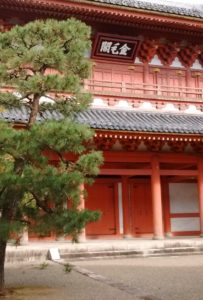
The kōgō was made for the 650th anniversary of the founding of Daitokuji by Dai-tō Koku-shi, 大燈国師, Great-lamp Country-master, in 1315 – 1319? Made of wood from the original structure of the San-mon, 三門, Three-gate, of Daitokuji, that was unused in its major reconstruction and restoration in 1971. The first floor of the great three entrance gate was completed in 1529, and in 1589, Sen no Rikyū made a major change. The upper story was designed and commissioned by Rikyū for his father’s 17th memorial. The second story is named, Kin-mo-kaku, 金毛閣, Gold-hair-pavilion; the Buddha is said to have had golden hair. Within this worship hall are the statues of Rikyū and sixteen Ra-kan, 落款, Spread-China, Buddhist arhats.
Dai-tō Koku-shi, 大燈国師, Great-lamp Country-master, [1282–1337], was one of the great leaders of the Rinzai sect in Japan. Daitokuji is the important center of Zen and Tea in Kyōto, as well as throughout the world, and many of the temples have Tearooms.


